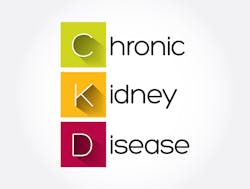Algorithm Scans EHR Data for Signs of Chronic Kidney Disease
An algorithm developed by researchers at Columbia University in New York can scan electronic health record data to help diagnose chronic kidney disease earlier.
Approximately one in every eight American adults is believed to have chronic kidney disease, but only 10 percent of people in the disease’s early stages are aware of their condition. Among those who already have severely reduced kidney function, only 40 percent are aware of their diagnosis.
According to the Columbia researchers, the reasons for under-diagnosis are complex. People in the early stages of chronic kidney disease usually have no symptoms, and primary care physicians may prioritize more immediate patient complaints.
The algorithm, developed by researchers at Columbia’s Vagelos College of Physicians and Surgeons, scours a patient’s electronic medical record for results of blood and urine tests and, using a mix of established equations and machine learning to process the data, can alert physicians to patients in the earliest stages of chronic kidney disease.
In a recent story posted on the Columbia website, study leader Krzysztof Kiryluk, M.D., associate professor of medicine at Columbia University Vagelos College of Physicians and Surgeons, explained the challenge: “Identifying kidney disease early is of paramount importance because we have treatments that can slow disease progression before the damage becomes irreversible. Chronic kidney disease can cause multiple serious problems, including heart disease, anemia, or bone disease, and can lead to an early death, but its early stages are frequently under-recognized and undertreated.”
Two tests, one that measures a kidney-filtered metabolite in blood and another that measures leakage of protein in urine, are needed to detect asymptomatic kidney disease.
“The interpretation of these tests is not always straightforward,” Kiryluk explained. “Many patient characteristics, including age, sex, body mass, or nutritional status, need to be considered, and this is frequently under-appreciated by primary care physicians.”
The algorithm automatically scans electronic medical records for test results, performing the calculations that indicate kidney function and damage, staging the patient’s disease, and alerting physicians to the trouble.
According to their study recently published in npj Digital Medicine, the algorithm performs nearly as well as experienced nephrologists. When tested using electronic health records from 451 patients, the algorithm correctly diagnosed kidney disease in 95 percent of the kidney patients identified by two experienced nephrologists and correctly ruled out kidney disease in 97 percent of the healthy controls.
The algorithm can be used on different types of EHR systems, including those with millions of patients, and could be incorporated into a clinical decision support system that helps physicians by suggesting appropriate stage-specific medications. The algorithm also could be updated easily if standards for diagnosing kidney disease are changed in the future and is freely available for use by other institutions.
Kiryluk noted that one drawback of the algorithm is that it depends on the availability of relevant blood and urine tests in the medical record. The blood test is fairly routine, but the urine test is underutilized in clinical practice, he added.
Despite these limitations, algorithmic diagnosis could enhance awareness of kidney disease, he said, and, with earlier treatment, potentially reduce the number of people who lose kidney function.
Because it can be applied to EHR datasets with millions of patients and identify all patients with chronic kidney disease, not just those diagnosed with the disease, the algorithm improves the power of many research studies, the Columbia story noted.
The researchers have already applied the algorithm to a database of millions of Columbia patients to find previously unrecognized associations between chronic kidney disease and other conditions. For example, depression, alcohol abuse, and other psychiatric conditions were considerably more common among patients with mild kidney disease compared to patients with normal kidney function, even after accounting for differences in age and sex.
In the future, Kiryluk said, the algorithm could be used to better understand the inherited risk of chronic kidney disease, because the algorithm empowers genetic analyses of millions of people to discover new kidney genes.


